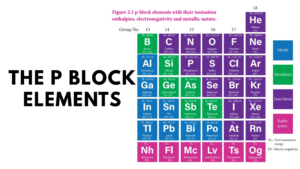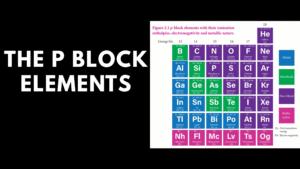The p-block elements occupy the right side of the periodic table and include a diverse range of elements such as non-metals, metalloids, and metals. These elements belong to groups 13 to 18 and play a vital role in chemistry because of their variable oxidation states, wide range of compounds, and unique properties.

This chapter is extremely important for Class 12 students because questions often come directly from these topics in board exams as well as competitive exams like JEE and NEET.
In these notes, we will cover:
-
Group-wise elements
-
Trends in properties
-
Important compounds and reactions
-
Concepts like inert pair effect, catenation, and allotropy
-
Applications and uses
Class 12 Chemistry Notes – The P Block Elements | Complete Guide with Questions
Overview of The P Block Elements
Position in the Periodic Table
-
Groups: 13 to 18
-
Includes: Non-metals, Metalloids, and Metals
-
Helium is in group 18 but belongs to the s-block due to its 1s² configuration.
Electronic Configuration
-
General configuration: ns²np¹–⁶
-
Number of p electrons increases from 1 to 6 across the period.
Oxidation States
-
Shows variable oxidation states.
-
Maximum oxidation state = Group number – 10 (for p-block metals).
Example: For Group 15 → 15 – 10 = +5 maximum oxidation state.
General Trends in The P Block Elements
Atomic and Ionic Radii
-
Increase down the group: New shells are added.
-
Decrease across the period: Effective nuclear charge increases.
Ionization Enthalpy
-
Increases across the period: Stronger attraction between nucleus & electrons.
-
Decreases down the group: Outer electrons are far from the nucleus.
Electronegativity
-
Increases across the period: Non-metallic character increases.
-
Decreases down the group: Metallic character increases.
Metallic Character
-
Increases down the group: Lower electronegativity and larger size.
-
Decreases across the period: Non-metallic character dominates.
Oxidation States Trend
-
Lighter elements: Higher oxidation states are stable.
-
Heavier elements: Lower oxidation states become stable due to Inert Pair Effect.
Group 13 – The Boron Family
Elements:
B, Al, Ga, In, Tl
Important Points:
-
Electronic configuration: ns²np¹
-
Boron: Metalloid; others: metals
-
Oxidation states: +3 (stable), +1 (inert pair effect)
Important Compounds:
-
Boric Acid (H₃BO₃)
-
Weak acid, antiseptic properties.
-
-
Boron Trifluoride (BF₃)
-
Strong Lewis acid, forms adducts.
-
-
Aluminum Chloride (AlCl₃)
-
Used in Friedel–Crafts reaction as catalyst.
-
Uses:
-
Boron: Neutron absorber in nuclear reactors.
-
Aluminum: Packaging, utensils, construction material.
Group 14 – The Carbon Family
Elements:
C, Si, Ge, Sn, Pb
Characteristics:
-
Electronic configuration: ns²np²
-
Carbon: Non-metal; Si, Ge: Metalloids; Sn, Pb: Metals.
Allotropes of Carbon:
-
Diamond: Tetrahedral, hardest material.
-
Graphite: Layered, good conductor.
-
Fullerenes (C₆₀): Spherical, used in nanotechnology.
-
Graphene: One-atom-thick layer, very strong.
Compounds:
-
CO₂: Greenhouse gas, acidic oxide.
-
SiO₂: Used in glass industry.
-
Silicones: Lubricants, water repellents.
-
Zeolites: Catalysts in petroleum industry.
Group 15 – The Nitrogen Family
Elements:
N, P, As, Sb, Bi
Characteristics:
-
Electronic configuration: ns²np³
-
Nitrogen: Diatomic, inert due to triple bond.
-
Oxidation states: -3, +3, +5
Important Compounds:
-
Ammonia (NH₃)
-
Used in fertilizers, cleaning agents.
-
-
Nitric Acid (HNO₃)
-
Strong oxidizing agent.
-
-
Phosphorus Allotropes
-
White (reactive), Red (stable), Black (least reactive).
-
Group 16 – The Oxygen Family (Chalcogens)
Elements:
O, S, Se, Te, Po
Characteristics:
-
Electronic configuration: ns²np⁴
-
Oxidation states: -2, +2, +4, +6
Compounds:
-
Ozone (O₃): Strong oxidizing agent.
-
SO₂: Used as a preservative.
-
H₂SO₄: King of chemicals, dehydrating agent.
Group 17 – The Halogens
Elements:
F, Cl, Br, I, At
Characteristics:
-
Electronic configuration: ns²np⁵
-
Highly reactive non-metals.
-
Exist as diatomic molecules: F₂, Cl₂, etc.
Compounds:
-
Hydrogen Halides (HX): Strong acids in water.
-
Interhalogen Compounds: XY, XY₃, XY₅, XY₇ types.
-
Bleaching Powder (CaOCl₂): Used for disinfection.
Group 18 – Noble Gases
Elements:
He, Ne, Ar, Kr, Xe, Rn
Characteristics:
-
Electronic configuration: ns²np⁶ (He: 1s²)
-
Chemically inert, monoatomic gases.
Compounds:
-
Xenon forms XeF₂, XeF₄, XeF₆.
-
Applications: Lighting, lasers, inert atmosphere for welding.
Important Concepts in The P Block Elements

1. Inert Pair Effect
-
Tendency of ns² electrons to remain paired → lower oxidation states stable in heavier elements.
2. Catenation
-
Ability to form long chains → Strong in carbon, decreases down the group.
3. Electronegativity Trends
-
Highest in fluorine → explains its reactivity.
4. Anomalous Properties
-
First element of each group shows unique properties due to small size, high electronegativity, and absence of d-orbitals.
Applications of P Block Elements
| Element/Compound | Application |
|---|---|
| Boron | Fiberglass, detergents |
| Aluminum | Construction, packaging |
| Silicon | Semiconductors, solar cells |
| Phosphorus | Fertilizers (Superphosphate, DAP) |
| Sulphuric Acid | Petrochemical industry, fertilizers |
| Halogens | Water purification, disinfectants |
| Noble Gases | Lighting (Neon), cryogenics (He), welding |
Summary Table
| Group | Elements | Oxidation States | Nature | Important Compounds |
|---|---|---|---|---|
| 13 | B, Al, Ga, In, Tl | +3, +1 | Metalloid + Metals | BF₃, H₃BO₃, AlCl₃ |
| 14 | C, Si, Ge, Sn, Pb | +4, +2 | Non-metals → Metals | CO₂, SiO₂, Silicones |
| 15 | N, P, As, Sb, Bi | -3, +3, +5 | Non-metals → Metals | NH₃, HNO₃, P₄O₁₀ |
| 16 | O, S, Se, Te, Po | -2, +2, +4, +6 | Non-metals → Metals | O₃, SO₂, H₂SO₄ |
| 17 | F, Cl, Br, I, At | -1, +1, +3, +5, +7 | Non-metals | HF, Interhalogens, Bleaching Powder |
| 18 | He, Ne, Ar, Kr, Xe, Rn | 0 | Noble gases (Inert) | XeF₂, XeF₄, XeF₆ |
Objective Questions-The P Block Elements
Q1. The oxidation state of nitrogen in nitric acid (HNO₃) is:
a) +1
b) +3
c) +5
d) +4
Answer: +5
Q2. Which is the lightest element in group 13?
a) B
b) Al
c) Ga
d) In
Answer: B
Q3. The chemical formula of bleaching powder is:
a) CaO
b) Ca(OH)₂
c) CaOCl₂
d) CaCl₂
Answer: CaOCl₂
Q4. Hybridization in BF₃ is:
a) sp³
b) sp²
c) sp
d) dsp²
Answer: sp²
Q5. Which gas is used in balloons?
a) N₂
b) He
c) O₂
d) Ar
Answer: He
Q6. Formula of ozone is:
a) O₂
b) O₃
c) O₄
d) O₂⁻
Answer: O₃
Q7. The oxidation state of sulphur in H₂SO₄ is:
a) +2
b) +4
c) +6
d) +3
Answer: +6
Q8. Which of the following is a noble gas?
a) Cl
b) O
c) Ar
d) N
Answer: Ar
Q9. The strongest oxidizing agent among halogens is:

a) I₂
b) Br₂
c) F₂
d) Cl₂
Answer: F₂
Q10. The inert pair effect is most common in:
a) Lighter elements
b) Heavier elements
c) Both equally
d) None
Answer: Heavier elements
Q11. The chemical formula of boric acid is:
a) H₃BO₃
b) H₂BO₃
c) H₄BO₄
d) HBO₂
Answer: H₃BO₃
Q12. Which allotrope of carbon is the hardest?
a) Graphite
b) Fullerene
c) Diamond
d) Graphene
Answer: Diamond
Q13. Oxidation state of phosphorus in P₄O₁₀ is:
a) +5
b) +3
c) -3
d) +4
Answer: +5
Q14. Which gas is used in cryogenics?
a) Ne
b) He
c) Ar
d) Kr
Answer: He
Q15. Which halogen has the highest electronegativity?
a) Cl
b) F
c) Br
d) I
Answer: F
Q16. Xenon forms the compound:
a) XeF₂
b) XeCl₂
c) XeBr₂
d) XeI₂
Answer: XeF₂
Q17. The oxidation state of chlorine in bleaching powder is:
a) +1
b) +3
c) +5
d) +7
Answer: +1
Q18. Which oxide is acidic in nature?
a) Al₂O₃
b) CO₂
c) CaO
d) ZnO
Answer: CO₂
Q19. Which halogen is liquid at room temperature?
a) Cl₂
b) Br₂
c) I₂
d) F₂
Answer: Br₂
Q20. The oxidation state of oxygen in ozone is:
a) 0
b) -1
c) -2
d) +1
Answer: 0
Short Answer Questions-The P Block Elements
Q1. Explain the inert pair effect with an example.
Answer:
The inert pair effect refers to the reluctance of the ns² electrons of heavier p-block elements to participate in bonding due to the poor shielding effect of d- and f-electrons. For example, in Group 13, thallium (+1) is more stable than thallium (+3).
Q2. Write the uses of boric acid.
Answer:
Boric acid (H₃BO₃) is used as an antiseptic, in the manufacture of heat-resistant glass (Pyrex), and as an insecticide. It is also used in the preparation of enamels and glazes.
Q3. What are interhalogen compounds?
Answer:
Interhalogen compounds are molecules formed by two different halogens. They have the general formulas XY, XY₃, XY₅, XY₇ such as ClF₃, IF₅. They are generally more reactive than halogens due to the difference in electronegativity.
Q4. Name the allotropes of phosphorus.
Answer:
Phosphorus exists as white phosphorus (highly reactive), red phosphorus (stable), and black phosphorus (least reactive). White phosphorus is stored under water to prevent combustion.
Q5. Why is nitrogen chemically inert at room temperature?
Answer:
Nitrogen (N₂) has a triple bond (N≡N) with very high bond dissociation energy, making it chemically inert under ordinary conditions.
Long Question And Answer –The P Block Elements
Q1. Describe the general trends in the physical and chemical properties of Group 16 elements.
Answer:
Group 16 elements (O, S, Se, Te, Po) show a gradual change in properties down the group. Atomic and ionic radii increase due to the addition of new shells, while electronegativity and ionization enthalpy decrease. The metallic character increases from oxygen to polonium. Oxygen shows anomalous behavior due to its small size, high electronegativity, and absence of d-orbitals, forming unique compounds like H₂O and O₃. The common oxidation states are -2, +2, +4, and +6, but stability of +6 decreases and that of +4 increases down the group due to the inert pair effect.
Q2. Explain the anomalous behavior of boron.
Answer:
Boron differs from other members of Group 13 due to its small size, high electronegativity, and absence of d-orbitals. It is a metalloid, while others are metals. Boron forms covalent compounds and exists as a network solid, while aluminum and others form metallic bonds. Boron shows diagonal relationship with silicon and forms compounds like borax, boric acid, and boron hydrides, which are not shown by heavier elements of the group.
Q3. Write a note on noble gas compounds.
Answer:
For a long time, noble gases were considered inert due to their stable octet configuration. However, in 1962, Neil Bartlett discovered the first noble gas compound XePtF₆. Later, xenon formed compounds like XeF₂, XeF₄, XeF₆, and XeO₃. These compounds are powerful fluorinating and oxidizing agents and find applications in chemical synthesis and lasers.
Electrostatics Class 12 Chemistry Notes | Complete Guide with MCQs
